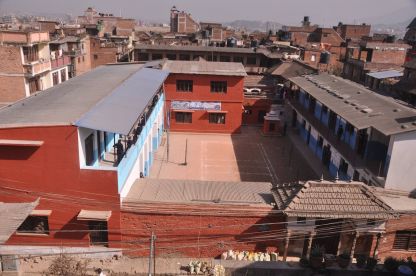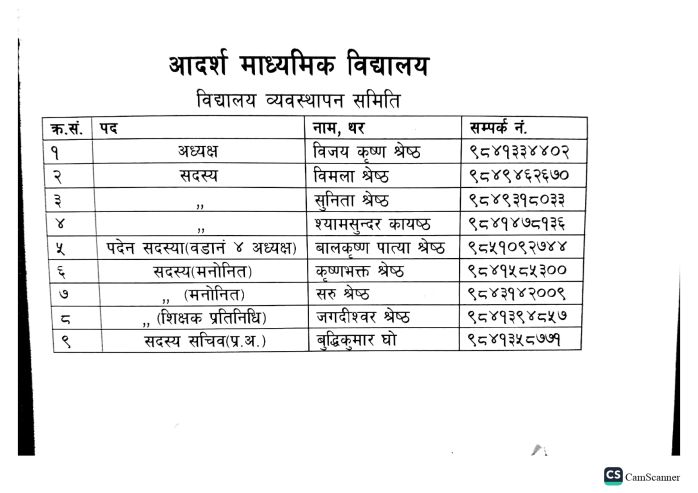Entrance Announcement
MICTE 2080
2080 Magh 07
Adarsha Secondary School ,Layaku
Background

This school report has been prepared for the completion of partial fulfillment of teaching practice of Bachelor 9th semester BICT as suggested Tribhuvan University. Teaching as an idea of transmitting knowledge to a particular person or group of person, religion or society and Practice as a way of putting ideas in action. Therefore Teaching practice is a part of a course for those who are trained to become professional teachers. From the beginning of human civilization people have been utilizing the value of education. Thus education is the backbone of human civilization as well as social development. Education helps for human civilization, globalization of thinking and technological development to be specific and the foundation of every sector of world lies on the education. School is a medium to spread the education in the society. It is a holy platform where a child gets many things for life. The child gets channels to be theoretically as well as practically knowledgeable about many subjects. The main aim of school is to develop the inner capabilities of the children. School helps for internal and external development of the children. A school is formal institute to teach the students. Nepal is a developing country, so the quality of education has not been developed yet. The main objective of education is habit formation. There is saying that education is nothing but making of habit. A school should be responsible to form better habit of children. Shree Adarsha Secondary School, Layaku, Madhyapur Thimi this school survey report also tries to find the problems of school and recommendations further improvement. The environment of school should be so peaceful, that can change the behavior of child and produce capable citizens for the development of family, society and nation. This report has been prepared as far as possible around the obtainable data and information, historical development of school, objective of this school, physical environment, economic and educational aspects of school and recommendation for further improvements it is hoped that this report will be simple guideline to move this school effectively. It will also be useful for the people concern
History of School
This report is about physical, economic and educational study report of Shree Adarsha Secondary School, Layaku, Thimi. This school is situated at Madhapur Thimi Municipality ward no. 4 of Bhaktapur district, Bagmati province. It is 500m North from Purano Thimi and about 400m South from New Thimi. It was established in 2021 BS with an aim to eradicate the literacy rate of catch man area of school. It motives the attitude of people and community towards positive education. At first it was only up to primary level, but with the change of time it is up to secondary level.
Education is the backbone of the society and human civilization. It provides us pure and perfect knowledge and always encourages us towards great achievement. This school was established with a sole aim of spreading high knowledge among the people in the middle part of the Bhaktapur district. The school has 10-5-2-0 area lands with 8 buildings. There are 1118 students and 46 teachers with 3 administration helpers.
School Management Committee
The list of School Management School Management Committee:

Data
Student detail of Adarsha Secondary School:
| S.N. | Class | Boys | Girls | Total |
|---|---|---|---|---|
| 1 | 29 | 15 | 44 | |
| 2 | 1 | 13 | 27 | 40 |
| 3 | 2 | 24 | 33 | 57 |
| 4 | 3 | 22 | 24 | 46 |
| 5 | 4 | 21 | 39 | 60 |
| 6 | 5 | 35 | 31 | 66 |
| 7 | 6 | 47 | 75 | 122 |
| 8 | 7 | 49 | 37 | 86 |
| 9 | 8 | 54 | 51 | 105 |
| 10 | 9 | 51 | 52 | 103 |
| 11 | 10 | 48 | 34 | 82 |
| 12 | 11 | 106 | 74 | 180 |
| 13 | 12 | 67 | 60 | 127 |
| Total | 566 | 552 | 1118 |
Human Resources
The school's human resources consist of a diverse and skilled team dedicated to maintaining educational excellence across different levels. Led by Principal Tika Ram Pandey, the staff includes a Vice Principal, Secondary Incharge/Teacher, and a group of teachers distributed across secondary, lower secondary, and primary levels. The educators bring a range of qualifications, such as B.Ed., M.A., and M.Ed. These individuals play crucial roles in fostering a positive learning environment. Additionally, the team comprises a School Nurse, support staff like helpers, and a nurse, all contributing to the overall efficiency and functioning of the school. The collective expertise and commitment of the staff underline the school's dedication to providing quality education across various educational tiers. List of Teachers in School are given below:
| S.N. | TEACHER'S NAME | S.N. | TEACHER'S NAME |
|---|---|---|---|
| 1 | Buddi Kumar Gho | 24 | Sharda Devi Shrestha |
| 2 | Hari Bahadur Shrestha | 25 | Rajesh Shrestha |
| 3 | Dev Prasad Bhattarai | 26 | Bhakta Khatiwada |
| 4 | Sabita Adhikari | 27 | Namrata Adhikari |
| 5 | Kamal Prasad Bhattarai | 28 | Chandra Krishna Kapali |
| 6 | Jamuna Kumwar | 29 | Krishna Bhakta Shrestha |
| 7 | Rabindra Shrestha | 30 | Sangita Shrestha |
| 8 | Bhagwati Shrestha | 31 | Shyam Sundar Shrestha |
| 9 | Santosh Paudel | 32 | Badri Bahadur Paudel |
| 10 | MeghnathDahal | 33 | Netra Prasad Ghimire |
| 11 | Sita Panthi | 34 | Laxmi Pakuwal |
| 12 | Shova Bham | 35 | Amrita Chitrakar |
| 13 | Ishwor Lal Shrestha | 36 | Chan Keshari Shrestha |
| 14 | Jagadish Shrestha | 37 | Sushila Basnet |
| 15 | Buddhi Laxmi Shrestha | 38 | Durga karki |
| 16 | Hari Shundar Potamaha | 39 | Suraj Sherstha |
| 17 | Sushmita Dhakal | 40 | Sajip Dhare |
| 18 | Rochak Chakadhar | 41 | Ashmita Shrestha |
| 19 | Kishwori Pokhrel | 42 | Pushparatna Brajacharya |
| 20 | Ambika Shrestha | 43 | Gobinda Basnet |
| 21 | Krishna Kesari Shrestha | 44 | Sushil Basnet |
| 22 | Nani Maiya Thapa | 45 | Nanu Dhola |
| 23 | Sahanshila Shrestha | 46 | Abhiman Tamang |
ICT Resources
ICT (Information and Communication Technology) resources refers to the tools ,devices, and system that facilitate the use of technology for communication ,information management and educational purpose. In school ,ICT resources play a crucial roles in enhancing teaching and learning experiences. Here is a list of ICT resources used in school:
1.Computer
2.Laptop
3.Projector
4.CCTV
Use of ICT :
The use of Information and Communication Technology (ICT) resources in schools has become increasingly important in modern education. Using technology, like computers and laptops, has become really important for making learning more interesting and effective. These tools help teachers teach better and get students more involved in their lessons. Schools all around the world use these tools to make teaching and learning more exciting. Also, things like CCTV cameras help keep the school safe. They make sure everyone is secure and can focus on learning without worrying about safety. All these technologies work together to make school a better place for students to learn and grow.
1.Computers:
Schools incorporate computers into classrooms, computer labs, and administrative offices. Teachers utilize computers for lesson planning, and creating multimedia presentations. Students, in turn, engage in interactive learning through educational software, access digital textbooks, and develop essential computer literacy skills. Administrative staff use computers for record-keeping, communication, and school management tasks.
2.Laptops:
Laptops provide educators with flexibility, enabling them to move around the classroom while maintaining access to digital resources. Teachers use laptops for real-time assessment, collaborative lesson planning. Students benefit from the mobility of laptops during group projects and research activities.
3.Projectors:
Projectors are integrated into classrooms to enhance visual learning experiences. Teachers project educational content, conduct multimedia presentations, and showcase collaborative projects to the entire class. Projectors support dynamic and interactive lessons, capturing students' attention and catering to diverse learning styles.
4. CCTV:
Closed Circuit Television (CCTV) systems are strategically placed throughout the school premises to monitor and enhance security. These systems contribute to creating a safe and secure environment for both students and staff. CCTV footage is used for surveillance, incident review, and as a preventive measure against security threats. Following is a list of key ICT resources employed in schools: